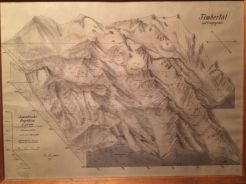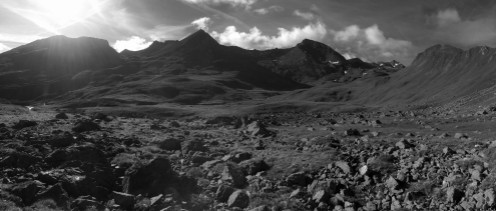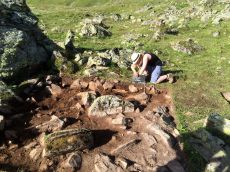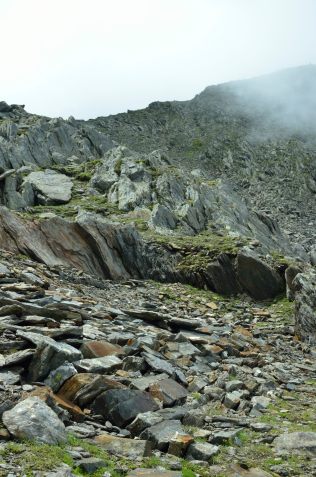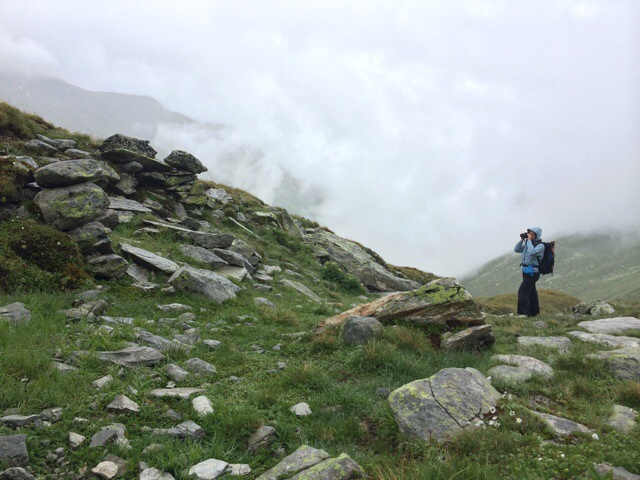“The Stone pine, each its own, unmistakable: born and growing on this very spot, while birds came and moved along and other birds came and left again. And she has turned old, ancient, she became ever more beautiful, more free, whether you look at her or not, one day she will die up here, torn by fire, thrown down by the dry hot föhn-wind, with her trunk hollow of age which will lie pale as bone, with its blunt branches, bumbs and horns on her almost indistructable patriarchical body.”
Andri Peer. «Daman da chatscha» / «Jagdmorgen» (1959/1961); my translation.
In German:
«Die Arve, jede sich selbst, unverwechselbar: geboren und gewachsen auf diesem Platz, während die Vögel gekommen und fortgezogen sind und andere Vögel gekommen und wieder gegangen. Und sie ist alt geworden, uralt, immer schöner, immer freier, ob du sie anschaust oder nicht, eines Tages stirbt sie hier oben, zerrissen von einer Feuerpranke, zu Boden geworfen vom Föhn, mit dem vor Alter schon hohlen Stamm, der noch Jahre und Jahre rein erbleicht mit seiner Knochenweisse, mit seinen stumpfen Ästen, Buckeln und Hörnern auf dem fast unverweslichen Patriarchenleib.»
Andri Peer. «Daman da chatscha» / «Jagdmorgen» (1959/1961)
In Peer’s text this magnificent stone pine, Pinus cembra (also known as the Arolla or Swiss stone pine) might stand as a symbol for the Romansh languange and culture and its perserverence (ca. 60.000 people speak one of its dialects). It reminds me of the piece of wood that was cut from a trunk in an alpine moor at 2363 masl in Las Gondas. The Las Gondas moor lies just below the Fuorcla da Tasna, above the Lower Engadin valley. Because a sample taken from the tree trunk could be dendrochronologically dated, we know it grew and grew old here over eight and a half thousand years ago. But already almost 2000 years before that Arolla pine grew here, as needles from that time have been found in the Las Gondas moor.
If you have never been there, you should visit the Tamangur forest on the southern side of the Lower Engadin valley. It is fantastic to walk through this open forest high in the Alps, a forest made up almost exclusively of Stone pines. Alive there is a softness about them, with their many small bundles of each five needles. But they can also appear almost archaic, their bare roots arching into the soil below. There is not much undergrowth, low bilberry bushes and alpenroses, the ground soft with needles, moss and grass.

Die knochenweissen Arven von Sursass, im Hintergrund der Piz Lindard bei Lavin. (Foto: Rudolf Grass, Zernez) Bild: Simon Schmid Aus Ganzoni in Der Bund 02.01.2015
Tamangur forest is one of the last of its kind. I am at the moment trying to write an article about the Mesolithic of the Alps of southeastern Switzerland. We know that 10’000 years ago, with the glaciers still retreating, people were already at similar altitudes not far from Las Gondas and they might well have walked in the cool shade of the very Stone pines that shed their needles and left their trunks in Las Gondas. They might have sheltered under the enormous rocks in the Plan da Mattun and have rested on the bare, bleached bone roots and trunks of these ancient trees.
Literature:
Dietre, B., Walser, C., Lambers, K., Reitmaier, T., Hajdas, I., Haas, J.-N., 2014. Palaeological evidence for Mesolithic to Medieval climatic change and anthropogenic impact on the Alpine flora and vegetation of the Silvretta Massiv (Switzerland/Austria). Quarternary International 353, 3-16.
Ganzoni., A., 2015, Aufgetaucht: «Das verborgenere Engadin». Fundstücke aus dem Schweizerischen Literaturarchiv: Eine Fotokarte des Engadiner Schrifstellers Andri Peer, in: Der Bund 02.01.2015 (last visited 16.01.2015)
Nicolussi, K., 2012. Jahrringdaten zur Früh- und mittelholozänen Baumgrenze in der Silvretta, in: Reitmaier, T. (Ed.), Letzte Jäger, Erste Hirten. Hochalpine Archäologie in der Silvretta. Amt für Kultur, Archäologischer Dienst Graubünden, Chur, pp. 87-100. (PDF of an older version).
Reitmaier, T., 2012. Letzte Jäger, erste Hirten. Alpine Archäologie in der Silvretta 2007-2012, in: Reitmaier, T. (Ed.), Letzte Jäger, erste Hirten. Hochalpine Archäologie in der Silvretta. Amt für Kultur, Archäologische Dienst Graubünden (ADG), Chur, pp. 9-65.



